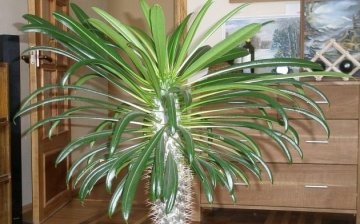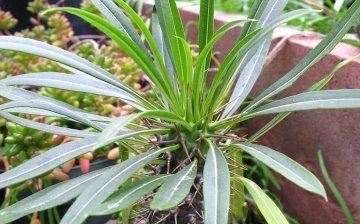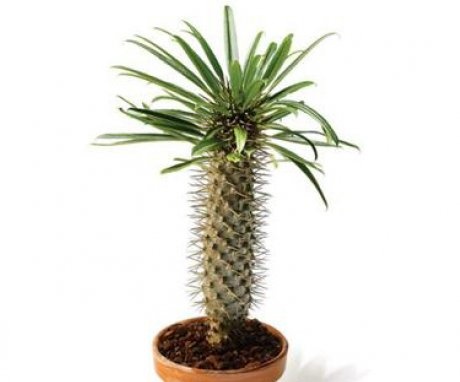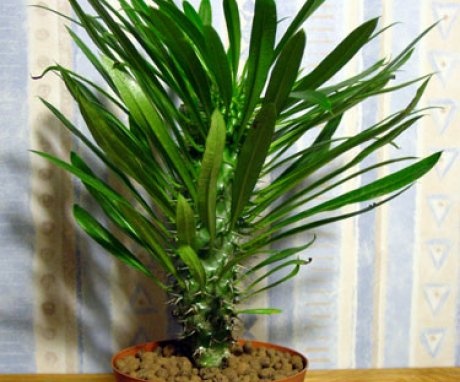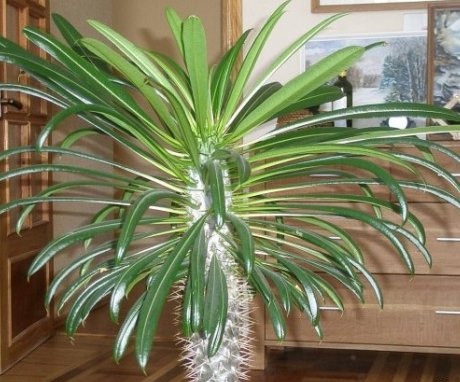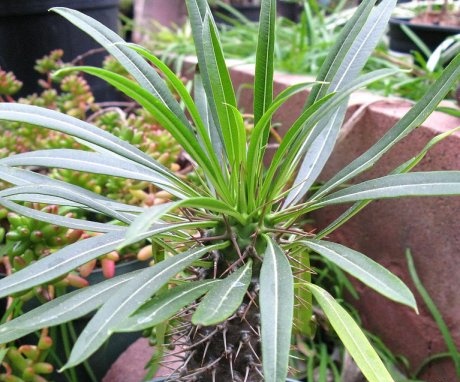Pachypodium: home care and growing secrets
Pachypodium - amazing tropical plant, which resembles both a cactus and a palm tree, for which lovers of succulents and unusual indoor flowers appreciate it. Its other name is Madagascar palm, although in fact it does not belong to palms at all. This is a drought-resistant plant that attracts not only with its unusual appearance, but also with its beautiful flowering. It enjoys the well-deserved love of flower growers due to its unpretentiousness; it will not be difficult to grow it on the windowsill.
Content:
- The appearance and features of the pachypodium
- Basic rules for the care of the pachypodium
- Common pests and major diseases
- Some important growing conditions
The appearance and features of the pachypodium
In nature, the Lamer pachypodium, the most common among indoor species, reaches 10 meters in height, of course, it will not grow so large in a room. In total, more than 20 species of this plant are known, in natural conditions they are found mainly in Madagascar and in southern Africa.
The main condition for growing is a sufficiently high temperature: all representatives grow in the tropics and need a warm climate.
Outwardly, it is difficult to confuse it with any other plant: the pachypodium has a thick stem on which spines and narrow elongated leaves grow. Several thorns are hidden under each leaf - this is the protection of the plant from natural enemies in the wild.
Its name comes from the Greek language and literally translates as "thick leg". It owes this name to its ability to accumulate moisture in the stem, like many other succulents. Thanks to this, he tolerates drought rather calmly, although at home it is better to provide him with regular watering... It multiplies seeds, growing slowly: the average growth is about 5 cm per year. At about the fifth year of life, under good conditions, the plant begins to bloom with large white flowers.
Basic rules for the care of the pachypodium
Although this is a rather unpretentious plant, if you want to achieve its flowering, you need to properly grow the pachypodium: home care is usually not difficult, it can be grown in an apartment.
Basic requirements and patterns:
- The room temperature should not drop below +16 degrees. Some species, such as the Lamera pachypodium, are capable of withstanding temperatures up to +8, but most of them require a warm climate. In the summer, the plant can be taken out on the balcony, it feels comfortable in the fresh air.
- The ideal lighting option for him is partial shade: the pachypodium does not like the bright sun, but the lack of light will negatively affect its growth. It is necessary to accustom the plant to open sunlight gradually, first taking it out to the balcony for a few minutes a day.
- The soil should be loose with neutral acidity. The best option is a mixture of turf, sand and leafy earth; additionally, you can add pieces of clay and charcoal. The pachypodium requires the obligatory creation of a drainage layer: it can reach up to 1/3 of the pot in height.
- For feeding it is necessary to use complex fertilizers: they are applied to the soil in spring and summer, the interval between fertilizing should be 1 month. You can use ready-made cactus fertilizers, they are suitable for many succulents.
- Transplant the plant is needed no more than once every two years, it is advisable to do this less often. The pachypodium has delicate roots that can be easily damaged when transplanted, in addition, it does not grow too quickly, therefore pot do not have to change often.
- Watering necessary during periods of growth, and it must be abundant. The question of how often it should be watered remains open. Some growers insist on regular watering in 1-2 days, others advise to wait until the earthy clod dries out by -2 cm. Practice shows that the second option is more correct, since there is less risk of root rot. You can check the ground by simply feeling it with your finger.
These are the basic conditions for good growth, which will eventually lead to flowering. It is worth propagating the pachypodium only by seed, planting pieces of stems usually does not give results, since they grow extremely slowly. However, if the lower part of the plant has suffered from rotting, you can try cutting the trunk and planting it in a pot. The trunk will give roots and the pachypodium will be saved.
Common pests and major diseases
Although the pachypodium is an undemanding plant, it can suffer from some pests and diseases... It cannot be watered with cold water: the lower leaves begin to blacken and fall off. Water for irrigation can only be taken at room temperature, while it is advisable to let it settle for several days.
With a lack of light, problems with growth can be observed: the leaves turn pale, losing their natural bright color, they can gradually begin to fall off. It is necessary to provide good illumination: it is advisable to find a place for the pachypodium on the southern or western windows. With an excess of moisture, the roots may begin to rot: in this case, watering must be stopped to allow the earth to dry out. Then it is spilled with a fungicide - the agent will kill bacteria and stop the decay process.
The main enemies of the pachypodium are scale insects and spider mites.
The latter settles on the leaves, feeding on their sap, as a result of which first a white bloom appears on them, and then they dry up and fall off. A spider mite is able to completely destroy a plant if it is not treated with special drugs... You can buy them at a veterinary pharmacy: the active substance is diluted in the amount of water indicated on the package, after which the plant must be sprayed, and the earth must be shed well or replaced altogether. The mite quickly spreads to all plants on the windowsill, therefore, when found, the pachypodium will need to be isolated from other flowers.
Some important growing conditions
It should be remembered that the pachypodium is a poisonous plant. It cannot be placed in the children's room, it is necessary to protect it from the encroachment of pets. In case of cuts and bites, milky juice is released from the leaves, if it gets on the skin, it must be thoroughly rinsed. In addition, it is a thorny plant, and the child can scratch quite hard on it.
Growing tricks:
- The Madagascar palm tree is afraid of drafts, so it should not be placed under the window, this can lead to serious diseases.
- It tolerates low air humidity calmly, as well as high temperature, so it can be safely placed near heating radiators.
- During the growth period, it is undesirable to rearrange the flower from place to place and turn it. This can cause blackening and dropping of the lower leaves.
- Sharp temperature jumps are extremely undesirable: any changes during the year should be made gradually: in winter, the pachypodium slows down growth, at which time it tolerates a drop in temperature more calmly.
The Pachypodium is a unique tropical guest on our windowsills. This is a beautiful and very unusual plant that requires careful attitude and care. In return, it will delight the owner with fast growth and magnificent flowers that will become a real decoration of the house. Taking care of it is not difficult at all, which makes it even more suitable for any apartment.
More information on plant propagation can be found in the video.






